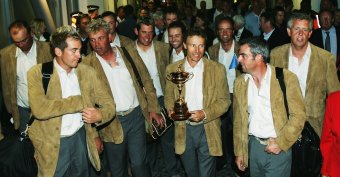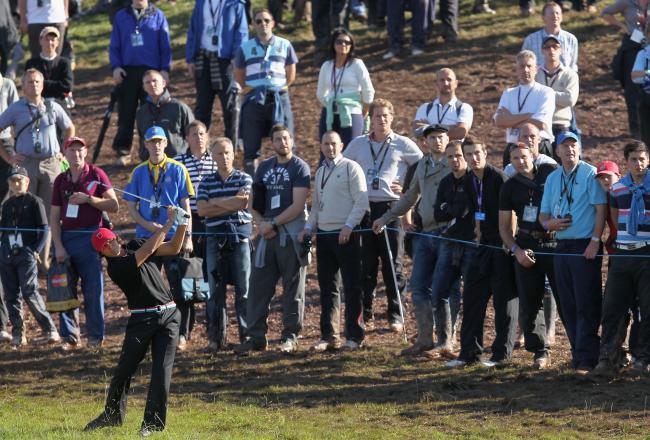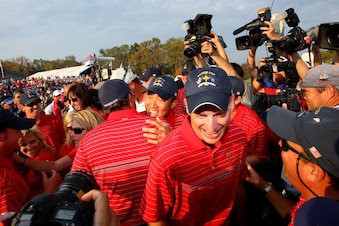The Ryder Cup has
not always been played in September. In fact, it has not always been
played in the fall. With so many power-packed events in August and
September these days, should some thought be given to a change of date?
Would it be better in the spring?
How much disruption would there be to the PGA Tour schedule? Could the PGA of America and the European PGA negotiate a new date any time of year with the PGA Tour and the European Tour?
Would a different date eliminate the ability to get the best players if they have not been tested by a season full of majors? Could the points list be generated from spring to spring instead of fall to fall?
What would happen in 2016 when golf goes into the Olympics if the Ryder Cup remains in its present slot?
Would the format need to be changed if there were a new date?
These are just a few of the many questions to consider when anyone considers a move for the Ryder Cup.
Originally, the Ryder Cup was a spring event. The first playing of the matches, in 1927, took place in June in Worcester, Massachusetts. The second, in April, in England in 1929. It moved to September for the first time in 1935 when the matches were contested in New Jersey. Two years later, it was back to June in England.
The 1939 event was slated for November in Ponte Vedra Beach, Florida, at the Ponte Vedra Beach Inn & Club, coincidentally four miles from today’s PGA Tour headquarters. However, it was cancelled due to fears of U-boat attacks during the Atlantic crossings. Amazingly enough, there was one U-boat battle near Jacksonville Beach and a U-boat landing at Ponte Vedra Beach, both in 1942.
http://dhr.dos.state.fl.us/preservation/markers/markers.cfm
Once WWII was over, it was decided that the matches should be reinstated. Oregon was the chosen location in 1947 with the match scheduled for November. The next time, it was England in September. For the next 20 years, Ryder Cup matches were held in either October or November. The following dozen contests were held in September, changing to October only in 1983 when the site was PGA National in Palm Beach Gardens. After this match, the timing switched back to September where it has remained. September, it seems, is where the Ryder Cup has landed.
The challenge of changing the schedule is not a simple one. PGA of America owns the US rights to the Ryder Cup and the European PGA owns the rights on the other side of the Atlantic. To change the date, they would have to discuss the issue with the PGA Tour and the European Tour. All four organizations would have to agree. It is not impossible to get it to happen. But what are the benefits, and downsides, if any, of a change?
A change in date would necessitate a change in the way the players earn their way onto teams. If the date changed to late May or early June, the points could be after The Masters or after The Players, and timing in the calendar and location could depend on, for example, where the US Open is held. From a daylight standpoint, the US Open has the best date, and with the six-hour rounds on the first two days, they need it. The first two sessions of the Ryder Cup, as currently constituted, need more daylight. A date close to the US Open slot would give the current format of play a better chance of finishing matches before dusk, which is what typically happens now. In fact, it would make so much sense that you can almost guarantee it will never happen. Never.
 Ryder Cup 2006
Ryder Cup 2006
Andrew Redington/Getty Images
Why is the date where it is?
The professional tour in Europe used to end in the fall. Having the Ryder Cup was a conclusion to the season as well as a near-conclusion to the PGA Tour season in the US.
Then Europe went global and began playing sanctioned events in Asia and Africa. That expanded the European season to an 11-month season. The PGA Tour is now a 10-month season, with November and December having some sanctioned or cosanctioned events. Dislodging a regular event for the Ryder Cup has become a routine for both tours, but dislodging them at a different time of year might be more of a challenge.
The main reason not to hold the Ryder Cup matches later than September is daylight. As everyone will see next week, it will be just after dawn when the first tee shot is hit and nearly dusk when the final putt drops. No one has yet figured out how to light up six holes of a golf course, although for some of the Tiger Woods Battle matches, there were lights on the last hole. (The Battle matches will return this fall with Woods playing Rory McIlroy on October 29th in China.)
Currently, we are fortunate to finish the matches on Thursday and Friday before sunset. Moving them to mid-October or sometime in November would likely require a change in format. There would have to be fewer points or fewer matches in the first two days, or a decision would need to be made to have the matches spread out over five days instead of three.
 2004 Ryder Cup
2004 Ryder Cup
Andrew Redington/Getty Images
For those who think the matches have always been played
in the order we have them today, that’s not the case. The format has
changed numerous times, as has the number of players on a side. Why not
make it a five-day phenomenon instead of a three-day ordeal? It would
give us so much more time for idle chitchat and postulating about who
is going to be paired with whom. Extend the fun. Have five days of
television. Alternatively, cut the number of players and matches,
although that would be hard to do given the high level of attention the
event has achieved in the last 20 years.
In the early years there were nine or ten players on each team. The total number of points has varied. There were even some years when 36 holes, two sets of 18-hole singles matches, were played on the last day. The format has not always been as it is today. It may be different 20 years from now.
The Olympics will provide a whole new wrinkle to professional golf calendars. It may cause all tours to be dark during the Olympic competition, which could encompass two weeks, one for the men and one for the women. However, the competition itself will not involve the majority of professional players. It will look more like the Noah’s Ark of professional golf.
First, the top 15 in the world rankings will play, but only four players from any one country can go. Right now, for the men, that would be Tiger Woods, Jason Dufner, Bubba Watson and Webb Simpson from the US. Everybody else from the US stays home. After the top 15, no country gets to send more than two golfers. Players from Northern Ireland have the choice of competing under Great Britain or Ireland, hence Rory McIlroy’s dilemma. Many have pointed out that after the top 15 or 20 players, countries will be sending golfers ranked 300 and over to compete against the likes of McIlroy and Woods. That’s not really a contest, but sometimes it’s about going and being a part of the experience. Who will be the Jamaican bobsled team of professional golf?
No matter how the teams are selected, it will affect the calendar. All the professional tours will be bumped one or two weeks down the road in an Olympic year. Now imagine how truly wasted a golfer would be after the British Open, WGC-Bridgestone, Olympics, PGA, FedExCup and then Ryder Cup. If there were ever a reason to make a date change for the Ryder Cup, putting the Olympics into the calendar may be it. That will affect all of Europe, and each country there will surely field a team of at least two people, which could negatively affect play of their Ryder Cup team.
How much disruption would there be to the PGA Tour schedule? Could the PGA of America and the European PGA negotiate a new date any time of year with the PGA Tour and the European Tour?
Would a different date eliminate the ability to get the best players if they have not been tested by a season full of majors? Could the points list be generated from spring to spring instead of fall to fall?
What would happen in 2016 when golf goes into the Olympics if the Ryder Cup remains in its present slot?
Would the format need to be changed if there were a new date?
These are just a few of the many questions to consider when anyone considers a move for the Ryder Cup.
Originally, the Ryder Cup was a spring event. The first playing of the matches, in 1927, took place in June in Worcester, Massachusetts. The second, in April, in England in 1929. It moved to September for the first time in 1935 when the matches were contested in New Jersey. Two years later, it was back to June in England.
The 1939 event was slated for November in Ponte Vedra Beach, Florida, at the Ponte Vedra Beach Inn & Club, coincidentally four miles from today’s PGA Tour headquarters. However, it was cancelled due to fears of U-boat attacks during the Atlantic crossings. Amazingly enough, there was one U-boat battle near Jacksonville Beach and a U-boat landing at Ponte Vedra Beach, both in 1942.
http://dhr.dos.state.fl.us/preservation/markers/markers.cfm
Once WWII was over, it was decided that the matches should be reinstated. Oregon was the chosen location in 1947 with the match scheduled for November. The next time, it was England in September. For the next 20 years, Ryder Cup matches were held in either October or November. The following dozen contests were held in September, changing to October only in 1983 when the site was PGA National in Palm Beach Gardens. After this match, the timing switched back to September where it has remained. September, it seems, is where the Ryder Cup has landed.
The challenge of changing the schedule is not a simple one. PGA of America owns the US rights to the Ryder Cup and the European PGA owns the rights on the other side of the Atlantic. To change the date, they would have to discuss the issue with the PGA Tour and the European Tour. All four organizations would have to agree. It is not impossible to get it to happen. But what are the benefits, and downsides, if any, of a change?
A change in date would necessitate a change in the way the players earn their way onto teams. If the date changed to late May or early June, the points could be after The Masters or after The Players, and timing in the calendar and location could depend on, for example, where the US Open is held. From a daylight standpoint, the US Open has the best date, and with the six-hour rounds on the first two days, they need it. The first two sessions of the Ryder Cup, as currently constituted, need more daylight. A date close to the US Open slot would give the current format of play a better chance of finishing matches before dusk, which is what typically happens now. In fact, it would make so much sense that you can almost guarantee it will never happen. Never.
 Ryder Cup 2006
Ryder Cup 2006
Andrew Redington/Getty Images
The professional tour in Europe used to end in the fall. Having the Ryder Cup was a conclusion to the season as well as a near-conclusion to the PGA Tour season in the US.
Then Europe went global and began playing sanctioned events in Asia and Africa. That expanded the European season to an 11-month season. The PGA Tour is now a 10-month season, with November and December having some sanctioned or cosanctioned events. Dislodging a regular event for the Ryder Cup has become a routine for both tours, but dislodging them at a different time of year might be more of a challenge.
The main reason not to hold the Ryder Cup matches later than September is daylight. As everyone will see next week, it will be just after dawn when the first tee shot is hit and nearly dusk when the final putt drops. No one has yet figured out how to light up six holes of a golf course, although for some of the Tiger Woods Battle matches, there were lights on the last hole. (The Battle matches will return this fall with Woods playing Rory McIlroy on October 29th in China.)
Currently, we are fortunate to finish the matches on Thursday and Friday before sunset. Moving them to mid-October or sometime in November would likely require a change in format. There would have to be fewer points or fewer matches in the first two days, or a decision would need to be made to have the matches spread out over five days instead of three.
 2004 Ryder Cup
2004 Ryder Cup
Andrew Redington/Getty Images
In the early years there were nine or ten players on each team. The total number of points has varied. There were even some years when 36 holes, two sets of 18-hole singles matches, were played on the last day. The format has not always been as it is today. It may be different 20 years from now.
The Olympics will provide a whole new wrinkle to professional golf calendars. It may cause all tours to be dark during the Olympic competition, which could encompass two weeks, one for the men and one for the women. However, the competition itself will not involve the majority of professional players. It will look more like the Noah’s Ark of professional golf.
First, the top 15 in the world rankings will play, but only four players from any one country can go. Right now, for the men, that would be Tiger Woods, Jason Dufner, Bubba Watson and Webb Simpson from the US. Everybody else from the US stays home. After the top 15, no country gets to send more than two golfers. Players from Northern Ireland have the choice of competing under Great Britain or Ireland, hence Rory McIlroy’s dilemma. Many have pointed out that after the top 15 or 20 players, countries will be sending golfers ranked 300 and over to compete against the likes of McIlroy and Woods. That’s not really a contest, but sometimes it’s about going and being a part of the experience. Who will be the Jamaican bobsled team of professional golf?
No matter how the teams are selected, it will affect the calendar. All the professional tours will be bumped one or two weeks down the road in an Olympic year. Now imagine how truly wasted a golfer would be after the British Open, WGC-Bridgestone, Olympics, PGA, FedExCup and then Ryder Cup. If there were ever a reason to make a date change for the Ryder Cup, putting the Olympics into the calendar may be it. That will affect all of Europe, and each country there will surely field a team of at least two people, which could negatively affect play of their Ryder Cup team.











0 comments:
Post a Comment